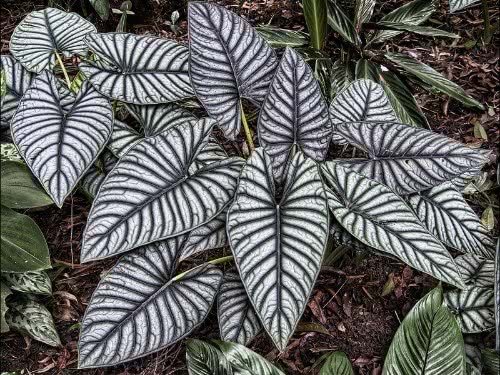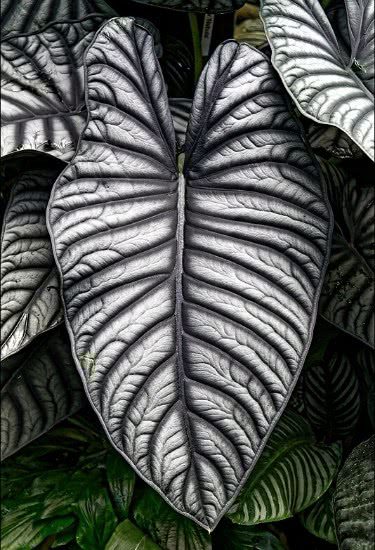The elephant ear plant is an herbaceous, rhizomatous, and perennial species with ornamental foliage. Originating from the tropical forests of Borneo, Indonesia, it brings a touch of the tropics to interior decoration and landscaping. Its leaves grow from 8 to 18 inches, with long petioles, a green-gray color, heart-shaped to arrow-shaped, and dark green stripes that emphasize its veins. These leaves are succulent and waxy, giving the species a unique texture. Depending on the growing conditions, the plant can develop a silvery hue with purplish reflections. The most common cultivars among collectors include ‘Imperialis’, ‘Balun’, and ‘Elaine’. Its inflorescence is a spadix with a spathe and holds little ornamental significance, as it grows on short stems, hidden by the leaves.

The Alocasia nebula bears resemblance to Anthuriums (Anthurium sp) both in appearance and its landscaping utility. Similar to anthuriums, it can be cultivated in pots, as indoor foliage, or as part of garden beds, as long as it’s placed in areas protected from direct sunlight. Its unique texture and color make it appealing for use in large, beautiful pots that can adorn corners, consoles, desks, side tables, and more. In the garden, it serves as ground cover in shaded wooded areas or as edging along pathways on the southern side.
Another interesting use is in vertical gardens, particularly those with an urban jungle style. Its large and intricately designed foliage is perfect for creating a tropical forest appearance on green walls. Additionally, the majestic projection of the leaves forward adds a thick and intriguing texture. It’s a low-maintenance plant, requiring occasional pruning to remove yellowed leaves, ensuring the plant’s health and beauty.
Cultivate it under filtered light to avoid direct sunlight, preventing leaf scorching. It thrives in tropical climates and prefers light, well-draining substrates with good moisture retention and organic matter. The optimal growth temperatures range from 64 to 77°F, and maintaining high humidity throughout the year is crucial. Despite this, it’s a slow-growing species. Watering should be slightly spaced out to avoid overwatering, while keeping the soil consistently moist. Preventing prolonged periods of dry soil is essential, as it can hinder its development.
Furthermore, like other species in the same genus, the elephant ear plant enters a dormancy period during cold winters and may shed some or all of its leaves. Don’t worry if this happens to your plants during this period; reduce watering and await spring when it will regrow. Propagation of the elephant ear plant can be done by dividing the underground rhizome in spring and summer. Repot every one or two years to accommodate growth and refresh the substrate.


